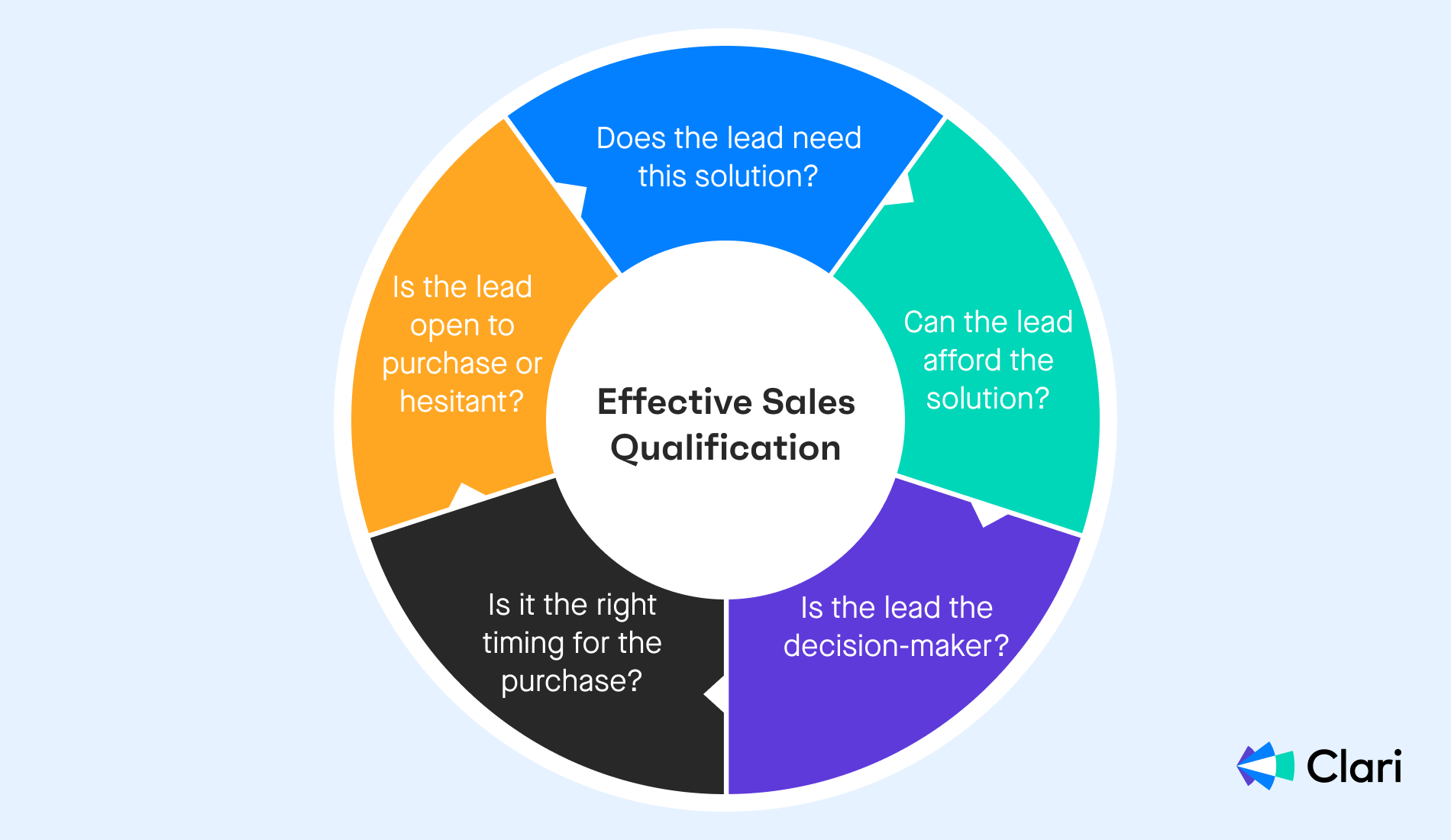Do you sometimes forget important questions amidst the hustle and bustle of a call?
Face general stress or anxiety when it's time to make discovery calls?
Feel overwhelmed by the volume of leads that the marketing team just handed to your team?
Well, first things first. You’re probably not going to have to pursue and nurture all those leads, so calm down! A lot of them are going to get eliminated after your discovery call.
Second, your symptoms are consistent with an ailment that is common among salespeople. It's called: not having a checklist or a roadmap for your discovery call.
As you may have guessed, the remedy is to simply develop a checklist that helps you avoid missing out on important questions in your interactions with prospects.
Actually, you need multiple checklists; one for making sure the lead has gone through various stages of qualification, another one to use as you prepare for your discovery call (if the lead makes it to that stage), and a third checklist of questions that will help you qualify the lead on the discovery call.
Sounds like a lot of checklists?
Don’t worry. We’ve got your back with this step-by-step guide.
Table of Contents:
- What is lead qualification, and why is it important?
- Why is a lead qualification checklist beneficial?
- What does the lead qualification process look like
- Prep checklist before your first call
- The 5 most important questions your lead qualification checklist should include
- 4 lead qualification frameworks to follow
- Breeze through lead qualification with Clari Copilot
What is lead qualification, and why is it important?
Lead qualification is a stage that happens early in the sales process to ensure your prospects need and can afford your product. Your reps research and ask qualifying questions to determine if they’re a good fit.
It’s clear why this matters. Solid qualification helps your sales team narrow the scope of their sales efforts. It helps your sales reps use more time on valid prospects, leading to more closed deals.
Why is a lead qualification checklist beneficial?
A lead qualification checklist ensures that your reps always properly qualify prospects before investing significant time and effort into them. It helps new reps hit the ground running without falling into the common trap of juggling too many leads, including low-quality ones.
And it’s not just about saving time. It’s about laying the right foundation with potential customers.
If you just give your reps an ideal customer profile, they can often approach calls in a way that feels like they’re actively trying to disqualify leads. A checklist structures the questions in a way conducive to building a strong relationship with your customers. It helps your reps ask qualifying questions correctly without feeling pushy, salesy, or too investigative.
What does the lead qualification process look like
The lead qualification process depends on how you structure your go-to-market teams, but when marketing and sales teams work together, the process looks like this:

Your marketing team attracts a potential lead—MQL (marketing qualified lead)
The marketing team runs lead generation efforts, including producing engaging content that resonates with your target audience. When someone signs up with their email address due to that content, the first stage of the lead qualification process kicks in. If someone, for example, downloads your company’s cheat sheet or interacts with content on social media, they can be qualified—to some extent—as worthy leads.
Note that we said “to some extent” because there could be other reasons that prospects reply to marketing outreach. Maybe they needed your cheat sheet for a university project, for instance.
These prospects wouldn’t be categorized as unqualified leads, but they are not fully qualified leads either. It's too early to spend valuable time on a sales pitch. MQLs still have two rounds of the lead qualification process before you can be sure that they’re worth any lead nurturing efforts.
Your sales team accepts the lead—SAL (sales accepted lead)
This is the next level of evaluating whether the prospect is worth any time and effort from the sales team. A SAL is an MQL verified and approved for further consideration by the sales team. During this stage, you might check a prospect out on LinkedIn and confirm that their job title and company match your buyer personas. You also evaluate their decision-making authority.
You find that they’re also in a sector that could benefit from your product. Your research tells you that they could be worthy of pursuing. SALs are promising leads who are more qualified than MQLs, but you need more information before you go after them.
(Some sales teams don’t work with inbound leads from marketing but mainly source their leads through prospecting. In that case, you research companies in your target market and consider and reach out to potential prospects at this stage).
A sales rep qualifies the lead on a discovery call—SQL (sales qualified lead)
The SQL tag is used for potential customers that the sales team has qualified—either through a discovery call or email. Their answers on the discovery call or email make them worthy of lead nurturing efforts by the sales team. You will have information such as: whether or not your prospect possesses authority for making buying decisions, their pain points, their budgets, and their timelines for purchasing a product like yours.
Prep checklist before your first call
If you jump on a call with every marketing-qualified lead, you’ll waste a lot of your time and energy on non-starters. You also risk jeopardizing high-value deals with viable prospects.
Here's a simple five-step checklist to ensure each rep upholds the larger sales strategy.

Confirm the relationship between the prospect and your company
Check if your company and the potential customer have connected previously by going through their CRM activity. A simple search should get you an answer. You might just find that they’ve actually shown interest in your solution on a prior occasion but couldn’t jump aboard due to unforeseen circumstances (like a pandemic, perhaps?).
Know the company better
Gather as much information as you can from LinkedIn, the company’s website, and any news about them. A sound understanding of the prospect’s company size and what it does helps you craft your value proposition better.
Don’t forget you have competition
You want to position your product as the best choice for qualified prospects. To do that, you need to be able to explain how you’re better than other options on the market. To make that argument, you need to know exactly what your competitors—traditional and nontraditional—bring to the table. For example, if you’re selling expense management software, you need to be able to argue how you’re better than other expense management software solutions. That’s expected. But what if they say they’re fine with spreadsheets? Or pen and paper? You need arguments against their current solutions, not just potential ones.
Ensure you have your agenda ready
Arm yourself with a list of qualifying questions that can get you the information you need in the short time frame of a discovery call.
Gather your resources
What if the lead asks for a demo? For a price list? For packages? Be sure to go into your discovery call prepared for a best-case scenario.
Want tips on delivering a stellar discovery call? Read our guide on how to ace your discovery call.
The 5 most important questions your lead qualification checklist should include
This checklist will help you ensure that your prospects have the budget, authority, and a real need for your product—at this time.
Ask the following qualifying questions to evaluate whether your sales lead is going to be worth your time, effort, free demos, discounts, charm, and everything else in your selling arsenal.

What is my lead’s budget? Can they afford my solution?
If they don’t have the budget, you’re going nowhere. Get this one out of the way at the outset if lacking budgets is a frequent reason for leads becoming a no-go in your context.
You want to ask questions like:
- Do you believe the price for your current product is reasonable?
- What is the pricing range that is reasonable to you?
You get an idea of the lead's budget without causing them any discomfort.
Is my lead the decision-maker?
You might not want to ask outright if they have the authority to make a purchase decision.
Instead, you might want to try more polite ways of getting the insight you need.
Ask questions like:
- Who is the right person to talk to about the challenges your business is facing?
- Do I have to contact anyone else?
Questions like these can help identify if the lead lacks authority.
Does my lead need my solution?
You wouldn't want to realize much further down the sales funnel (after you’ve wasted time and effort) that your leads cannot actually derive value from your product or solution. For example, what if they have some sort of compliance issue that doesn’t allow your solution—or any like it—to even be deployed? There’s no way they can use your solution, no matter how much they want to. That would mean that all the time and effort you’ve expended so far has been a complete waste.
Here are a few questions you'll want to ask them:
- What objectives are you prioritizing right now?
- What is holding you back from accomplishing your priority objectives?
- How are you going to overcome these obstacles?
Is this the best time for my lead to buy my solution?
A savvy sales rep never forgets to assess whether the timing is right. It could be the wrong time for a variety of reasons; the commonest is a lack of budget or an ongoing contract with another vendor. If the timing is not right, be genuine about wishing them well and defer your efforts to a better time (don’t forget to ask when they are likely to have the budget or when their current contract is up for renewal).
Check in with a Christmas or Thanksgiving greeting, perhaps, so that they don’t forget you.
Ask questions like:
- How soon do you think you might be able to make a purchase decision?
- How quickly do you need this problem resolved?
- What lead time do you need to carve out a budget for this solution/ to solve this problem?
Is my lead open to my solution or struggling with wariness?
Be sure to wrap your head around the issues that they are facing with the current or previous solution by asking questions such as:
- Have you tried to solve this problem before? What went right/went wrong with the chosen solution?
- What guarantees or assurances or proof of value do you need to feel confident that our solution will deliver as promised?
Any lead successfully qualified through all of these stages is an ideal client. But even if the timing or budget isn’t perfect, keep the leads in your sales pipeline in a less active stage.
4 lead qualification frameworks to follow
Sales reps can use popular qualification frameworks as checklists for qualifying leads. Most sales qualification frameworks are actually a collection of lead qualifying questions. Here are some of the most-used sales qualification frameworks for you:
CHAMP
Champ is a simple framework with four qualification criteria—challenges, authority, money, and priority.
- CHallenges: What are the challenges that the lead is currently facing?
- Authority- Does your lead have the job title and authority to make the final purchase decision?
- Money: Can your lead afford your products or services?
- Priority: How much does your prospect need your product?
BANT
BANT is a classic B2B sales qualifying framework that focuses on budget and authority, then moves on to need and timing.
- Budget: What is my lead’s budget? Are they able to afford my solution?
- Authority: Is this lead the decision-maker? Are multiple execs involved in the decision-making process?
- Need: Does my lead really need my product or solution?
- Time: Is now the right time for my lead to buy my solution?
MEDDIC
MEDDIC is a more advanced framework and qualification strategy focused more on proving the value of your solution.
Metrics: You want to measure and use metrics to convey your cost-value proposition. Does your prospect recognize the cost-value proposition? (Does your product deliver value to your prospect that justifies its price?)
Economic buyer: Does your prospect have the budget to purchase your product/ are they willing to create/ negotiate with stakeholders for a budget to overcome their struggles or achieve their goals?
Decision criteria: We’re focused on your checklists in this blog post, but you also need to find out about their checklist. What criteria are they using to judge you and make a decision on a solution?
Decision process: What is the prospect’s buying process like? Some companies, for example, have a three-quote rule for all vendors, and there’s no workaround.
Identifying pain points: What are your prospects’ pain points?
What are their struggles? What obstacles stand in their way? This is a very significant part of your qualifying questions because your prospect’s pain points tell you whether or not your product corresponds to a burning need and how great your prospect’s need is. Knowledge of their struggles also gives you the right words to say in conversations to come.
Champions: Maybe you have an ex-client at the prospect’s office or someone who has had a positive experience with your product (or maybe someone who seems to be biting the bait where others are wary in a meeting with multiple stakeholders from the prospect’s team).
If it’s someone who has used your product previously, you might suggest that your prospect verify your claims with them.
If they are warming to your solution more than others, maybe it’s because they are the most likely to benefit from it: maybe work with them to prioritize their needs with the prospect you’re in talks with.
Your champion might also be able to warn you when your competitors are being considered over you.
Competition: How are you better than the competition? When the prospect asks why we should choose you, as the sales rep, you should be able to answer them with a clear understanding of how you are different from your competition.
ANUM
ANUM starts by confirming authority, then jumps immediately to need and urgency. It confirms the budget last. This may be a better option if marketing delivers high-quality leads.
Authority: You know this one by now. Is your prospect the decision-maker for vendors or procurement of solutions?
Need: Does your prospect have a need gap that your product can bridge?
Urgency: How urgently does your prospect need your product or solution? How quickly are they likely to make a purchasing decision?
Money: Does your sales lead have the budget for your solution? ANUM puts budget at the bottom of the list and, in doing so, positions itself as the lead qualification framework for situations where budget isn’t a primary concern or a primary deciding factor.
Breeze through lead qualification with Clari Copilot
With Clari Copilot, you have access to all of the data you need to start qualifying leads. It arms you with automatic call transcription and note-taking so that your sales rep can focus on learning more about the prospect, being engaging, and ensuring that they cover all their qualifying questions.
This means they make a better impression and possibly forge a better bond with the prospect. After a successful call, your sales reps simply go back and retrieve all of the important lead score data from the call recording.
Experience Clari Copilot today with a free demo, and see the difference yourself.


